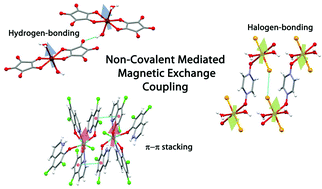Tailoring magnetic properties of molecular materials through non-covalent interactions
Abstract
Supramolecular non-covalent interactions, which drive the molecular packing of crystalline functional molecular materials, can be employed as effective tools for mediating magnetic exchange interactions. Specifically, directional hydrogen- and halogen-bonds and π–π interactions can be used to design materials in which their magnetic exchange pathways and strength can increasingly be predicted. Specific examples are presented herein and discussed with the aim of gaining deeper insight into the structure–property relationships that provide a powerful tool to afford new materials with unprecedented physical properties.

- This article is part of the themed collections: 2015 Inorganic Chemistry Frontiers Review-type Articles and Crystal engineering for molecular materials

 Please wait while we load your content...
Please wait while we load your content...